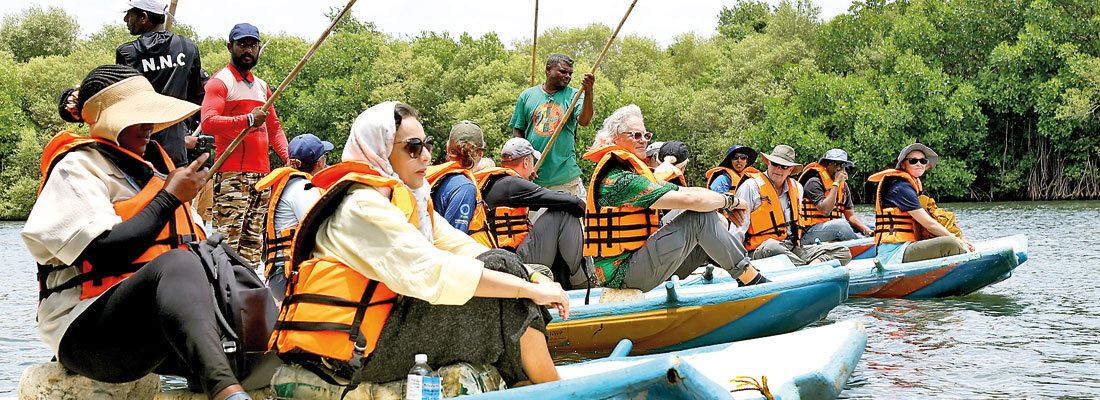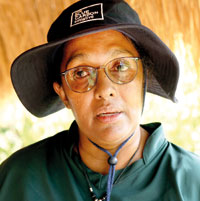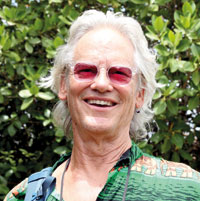News
Spotlight on our mangroves at International Blue Carbon Scientific Working Group meeting at Negombo
View(s):
Visiting the mangrove sites
Pix and text by Hiran Priyankara
An International Blue Carbon Scientific Working Group (IBCSWG) meeting is underway in Negombo with international participation, aimed at conserving and restoring coastal ecosystems.
Concentrating on Sri Lanka’s mangroves, the meeting is being attended by 150 scientists from 23 nations.

Prof. Sewwandi Jayakody
Professor Sewwandi Jayakody, a lecturer at the Wayamba University, told the Sunday Times that the IBCSWG meets frequently in areas that are hotspots for carbon emissions, with recent gatherings having taken place in 33 countries globally.
IBCSWG is part of the Blue Carbon Initiative (BCI), a coordinated worldwide effort aimed at protecting and restoring sea grass meadows, mangroves, tidal marshes and coastal ecosystems because of their importance to the global ecosystem.

Prof. Boof Kaufman
Scientists of IORA Blue Carbon Hub Think Tank and the International Blue Carbon SWG joined the meeting.
Part of the programme took place in the Anawilundawa Ramsar Wetland Site, which saw the world’s first mangrove restoration.
The importance of establishing a carbon-free ecosystem was emphasised by the scientists who highlighted the unique function of mangroves, tidal marshes and sea grass meadows and their importance for the global ecosystem.
The scientists got the chance to study the mangrove ecology of the Muthupanthiya Island, situated on the outskirts of Anawilundawa.
Expressing her views, Prof. Jayakody stated that it is a wonderful opportunity for
Sri Lankan ecologists who are currently working on these ecosystems, as well as for environmentalists and organisations enthusiastic about the environment.
“It enables us to learn from other nations about the obstacles they encounter in conserving mangroves, and how they are being preserved.”
Professor Boof Kaufman, Professor of Global Climate Change at the University of California, Berkeley, said “I was able to observe up-close the mangroves’ structure and beauty, and appreciate the benefits of preserving them. I could see that the government and other organisations are doing a lot to preserve these ecosystems.”
“I see Sri Lanka’s mangroves as a good investment for the country’s economy” he added.
Meanwhile the Wildlife and Nature Protection Society (WNPS) in a press release said that as the climate crisis accelerates, the Blue Carbon Initiative (BCI) stands as a coordinated global programme dedicated to conserving and restoring coastal ecosystems—mangroves, tidal marshes, and seagrass meadows—due to their importance to climate change mitigation, biodiversity and human well-being. The BCI is coordinated by Conservation International, Intergovernmental Oceanographic Commission (IOC) of UNESCO and IUCN.
BCI’s scientific basis, the International Blue Carbon Scientific Working Group (IBCSWG) helps advance current and emerging blue carbon science and, in so doing, facilitates policy and management for coastal ecosystem conservation and management.
Recent meetings of the IBCSWG were held in Cape Town (South Africa), Singapore, Mérida (Mexico), Edinburgh (Scotland), and Copenhagen (Denmark).
For over 131 years, WNPS has been synonymous with
wildlife conservation in
Sri Lanka, playing a pivotal role in the conservation of both terrestrial and marine ecosystems and their biodiversity. Being the third oldest conservation organisation in the world, and also serving as the science lead for Anawilundawa Mangrove Restoration Project of the Department of Wildlife Conservation, Sri Lanka, the Society is committed to ensure all timely topics related to Blue Carbon Ecosystems are highlighted during the conference.
The sessions of the meeting focus on the topics of Blue Carbon in Sri Lanka, Aligning Blue Carbon Biodiversity Methods, Updates from the Field, and Addressing Critiques of Blue Carbon from Science to Action. These discussions will feature internationally renowned experts and provide a platform for emerging Sri Lankan scientists to present their research. Selected young researchers from the Wayamba University will also be presenting products inspired and developed from materials found in blue carbon ecosystems. To conclude the meeting, a carbon-methane flux training will be conducted by the scientists of the Smithsonian Institution and Florida International University utilising instruments brought down from the USA for the training.
A full-day field visit to the Anawilundawa Ramsar Wetland Site—co-hosted by the Indian Ocean Rim Association (IORA) Blue Carbon Hub, BCI, the Department of Wildlife Conservation, the Forest Department and WNPS —will highlight the site’s rich biodiversity, the UN flagship award-winning Accelerated Natural Regeneration of Mangroves (ANRM) project, and community-based livelihood initiatives. Participants of both the 6th IORA Blue Carbon Hub Think Tank Meeting and the International Blue Carbon SWG Meeting will join this visit. The expected outcome of the meeting is to strengthen global collaboration, share experiences and expertise, and chart a path forward that balances the needs of local communities with ecosystem restoration and socio-economic priorities.
The best way to say that you found the home of your dreams is by finding it on Hitad.lk. We have listings for apartments for sale or rent in Sri Lanka, no matter what locale you're looking for! Whether you live in Colombo, Galle, Kandy, Matara, Jaffna and more - we've got them all!

